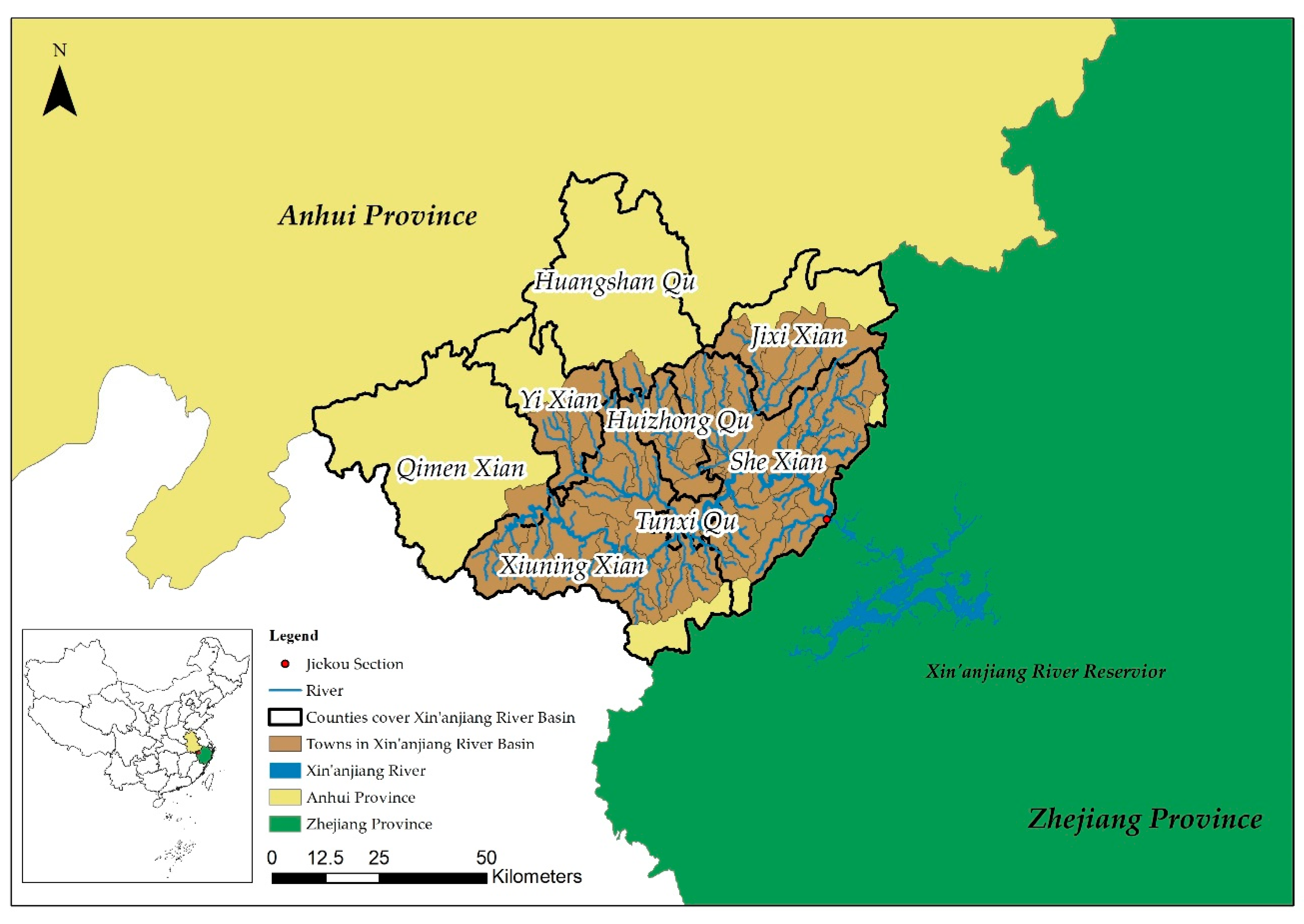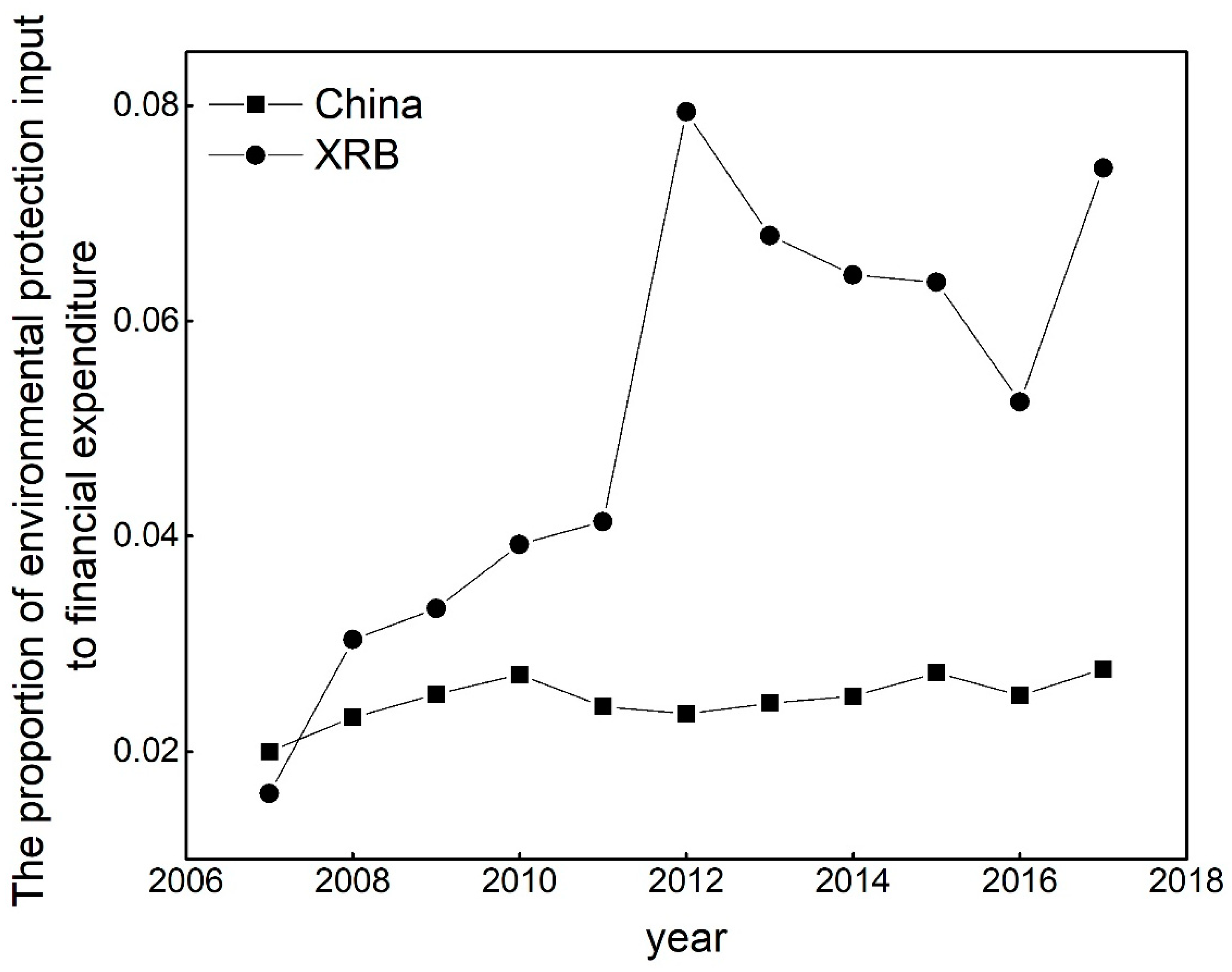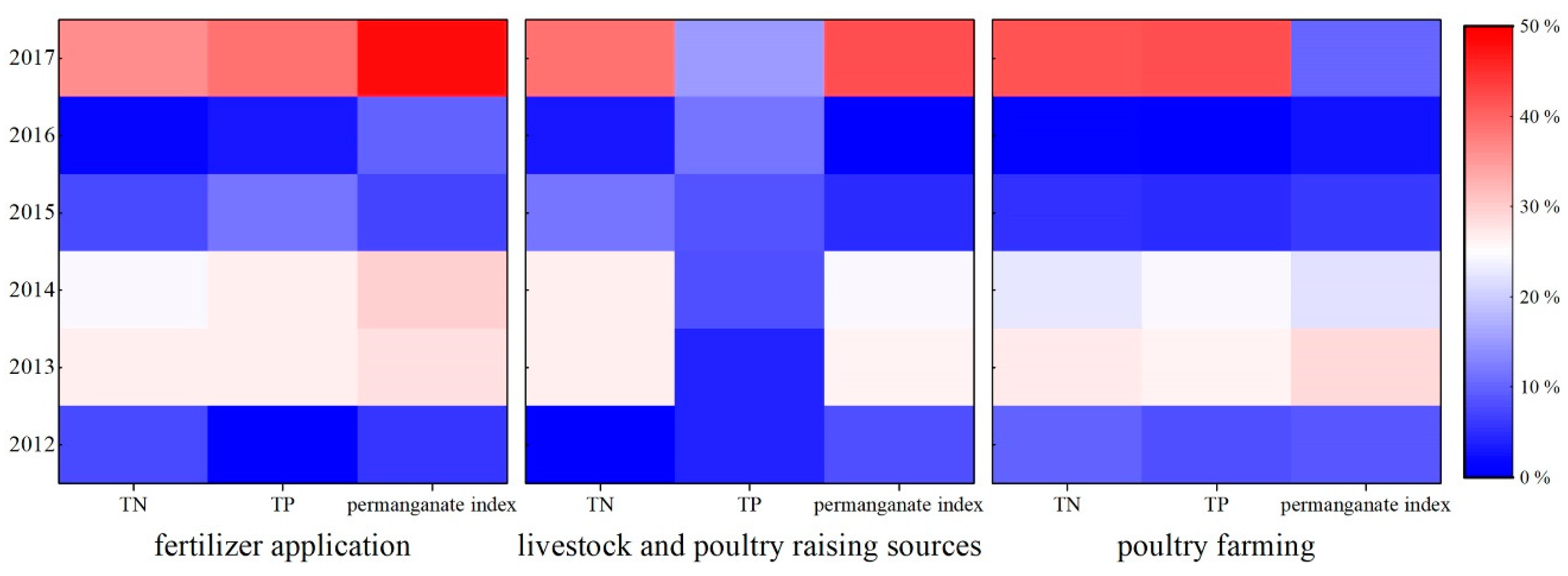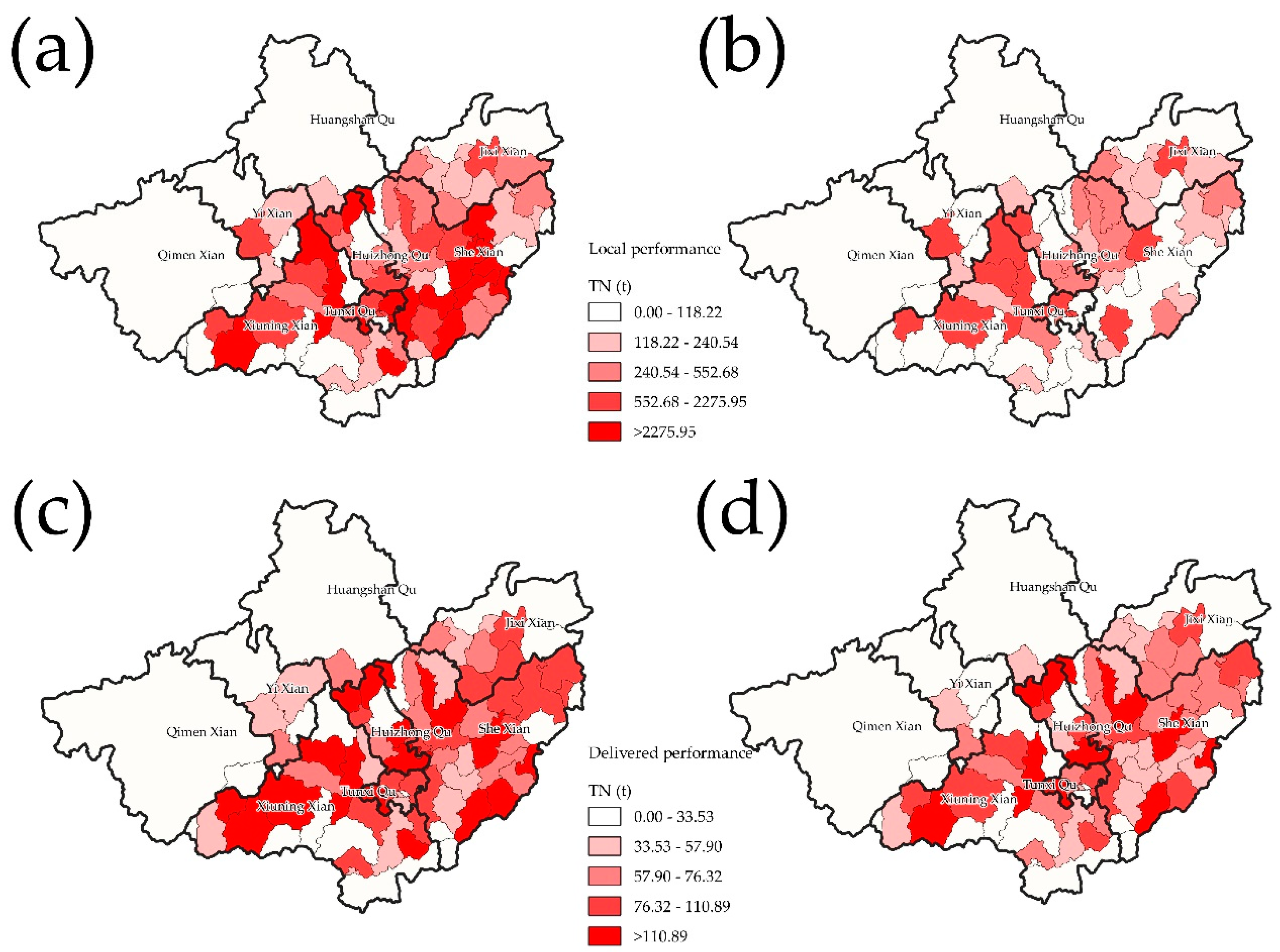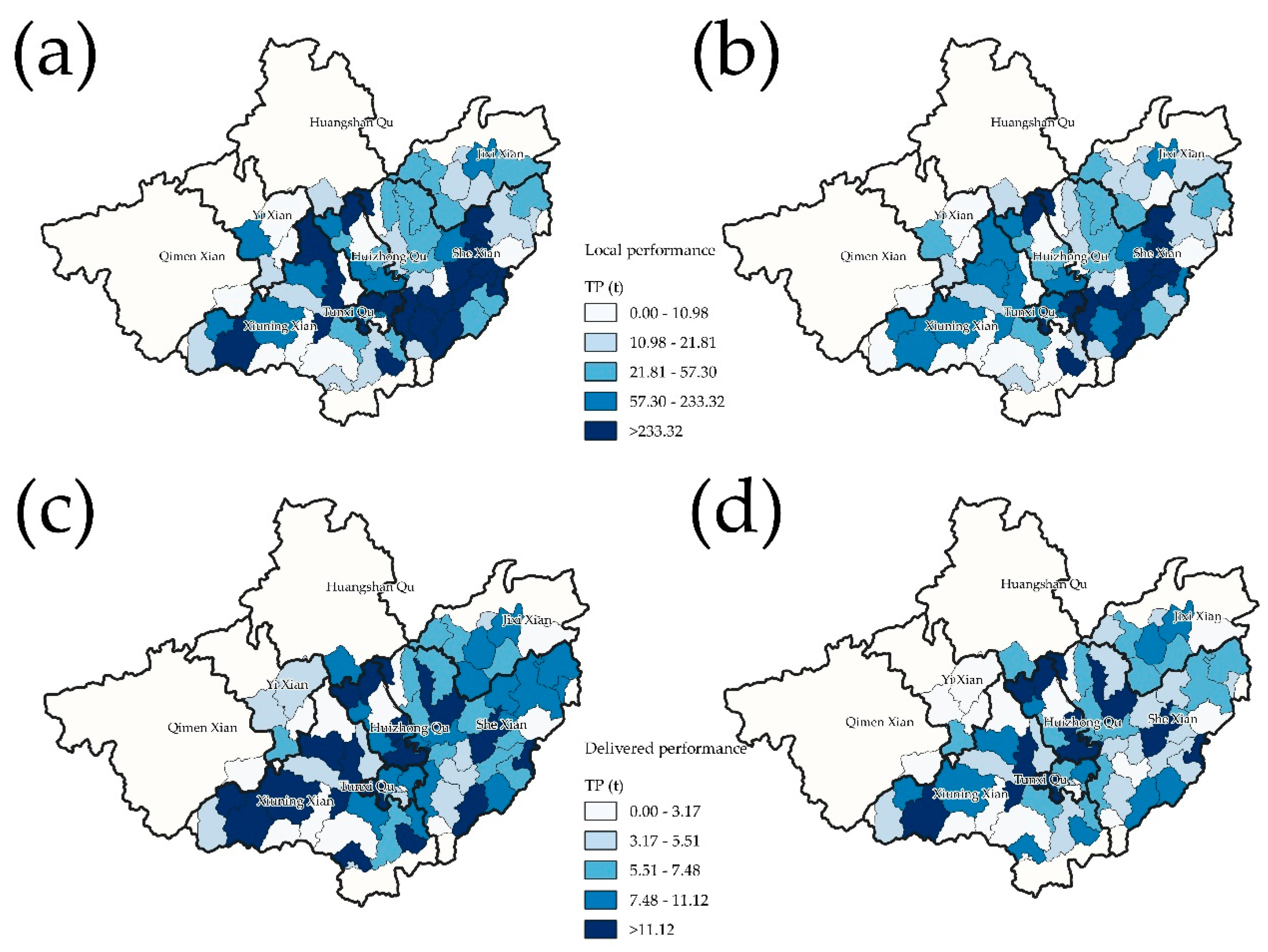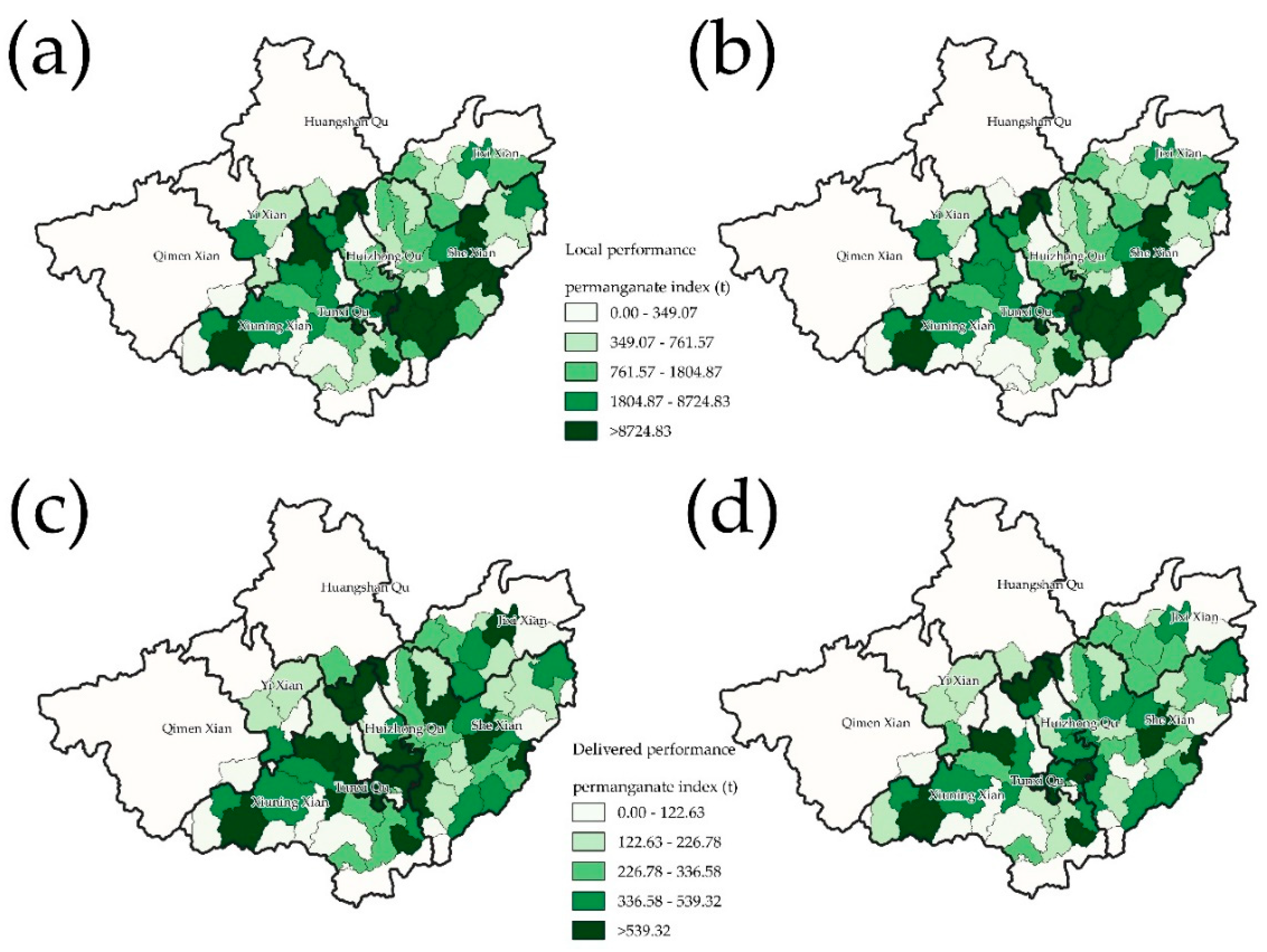1. Introduction
High-quality development will replace fast growth as a fundamental economic development target for China [
1]. China was gradually entering the new normal of economic growth [
2,
3,
4], under which the economic structure would be optimized and effects would far exceed those environmental regulations and policies [
5]. After decades of rapid economic development, water quality problems have become constraints for green development in China [
6]. To address devastating water environmental crises and to improve the quality of economic developments, China has already implemented multiple regional and national policies [
7,
8,
9]. It is important to find suitable environmental water management methods to adapt to China’s economic conditions and the administrative system. China’s existing water management system is managed in accordance with administrative regions instead of river basins [
10]. Ecological compensation is an important type of design and institutional arrangements coordinate regional development and ecological environment [
11,
12]. Ecological compensation in China has improved with the progress of environmental protection [
13,
14], making the definition close to the new concept of Payment for Ecosystem Services (PES) [
15]. However, the practice of river basin ecological compensation in China mostly exists within the jurisdiction of one province, and the practice across provinces with more complicated relations is rare.
After eight years of preparations, in 2012 the Ministry of Finance and the Ministry of Environmental Protection (renamed Ministry of Ecological Environment in 2018) in China formally launched the first demonstration project to address upstream-downstream ecological compensation across provinces in Xin’anjiang River Basin (XRB), which is of great guiding significance for China [
16]. XRB, located at the junction of Zhejiang province and Anhui province (
Figure 1), is the largest inflow river of the Qiantangjiang River system and Qiandao Lake in Zhejiang province. XRB and Qiandao Lake are not only important drinking water sources of Zhejiang and Anhui provinces [
17] but also ecological security barriers of the Yangtze River Delta region [
16].
Environmental protection has always been taken seriously in the XRB. The proportions of environmental protection input to financial expenditure in China and XRB are listed in
Figure 2 since 2007 [
18], which was the year that environmental protection spending began to take into fiscal spending in China. Data are collected from the Ministry of Finance of China and the Bureau of Finance in Huangshan City and Jixi County, which contain the XRB. Although in 2007, the proportions in XRB were greater than those in China. The financial expenditure had significant differences (
p < 0.05) before and after 2012, which was the year that ecological compensation began. Thus, we take the period of 2012–2017 as consideration of ecological compensation effects.
This project was divided into two stages from 2012 to 2017: first-round stage (2012–2014, XAJ1) and second-round stage (2015–2017, XAJ2), with the total spending of 146.32 hundred million Yuan (
Figure S1). With a guaranteed system, diversified funds, and reasonable basis of compensation (see
Supplementary Information for details), the mode in XRB was successfully demonstrated, guaranteeing the water quality of downstream. A sufficient preliminary investigation was made to determine the main direction of compensation funds. Each stage summarizes the achievements of each stage. The system ensures that the compensation funds are specifically used for the industrial structure adjustment and industrial layout optimization of the XRB, comprehensive river basin management, water environment protection, water pollution control, and ecological protection. The corresponding projects (
Table 1) include sewage treatment, garbage disposal, pesticide and chemical fertilizer treatment, livestock and poultry management, and comprehensive measures.
Identifying precisely how much environmental improvement was due to the compensation funds and whether the funds had been effectively used in different counties is important to evaluate the ecological compensation policy, and is crucial information for decision-makers, particularly in the new normal of China’s economy. We chose XRB as our study area not only because the standard of compensation is based on its water quality, but also because the compensation funds were all used to improve the water quality in the period of 2012–2017, which is typical for calculating the environmental performance. The environmental effects were evaluated through a historical trend (2007–2011) analysis of water quality loads to estimate the counterfactual (without ecological compensation) loads in the period of ecological compensation (2012–2017). Yet so far existing studies have focused on the standard mechanism of the ecological compensation [
14,
19]. Other research has examined the efficiency of payment of ecosystem services [
20,
21,
22]. However, there are no adequate analyses of the river basin ecological compensation performances with getting rid of the natural conditions’ influences.
This article aims to bridge this gap by innovatively using data envelopment analysis (DEA), which uses different kinds of environmental investments as input and counterfactual SPAtially Referenced Regression On Watershed attributes (SPARROW) model results in the watershed as output, to evaluate the environmental investments’ efficiency in different counties in the XRB. This approach should be generalizable to different areas and thus valuable beyond the immediate application. The next sections provide (1) a brief introduction of the data sources, the DEA method and SPARROW model and their applications in models, (2) a detailed analysis of each result, and (3) a discussion about the references of the successful approach of the first ecological compensation demonstration for crossing provinces of downstream and upstream in China. To our knowledge, this is the first use of counterfactual scenarios to estimate the environmental performances and related efficiencies in the valuation of ecological compensation. Influences of social and political impacts are beyond the scope of this piece of work due to the lack of data and related researches.
2. Materials and Methods
2.1. Data Sources
Precipitation data were provided in 48 precipitation data sites in the XRB. Water quality data were collected monthly at 60 sites. Flux data used to calibrate the curve numbers were provided by the Environmental Protection Bureau of Huangshan City and Jixi County. Fertilizers and pesticide data were both taken from Anhui statistic yearbook (2007–2017) and provided by XRB Environmental Protection Bureau. The population data were obtained from the government statistical agency website.
2.2. SPARROW Models
The SPARROW water-quality model is a nonlinear least-squares multiple regression model to estimate pollutant sources and tracks the sources of the contaminants [
23,
24]. This model has been already used successfully in the XRB [
17]. To better illustrate the effect of ecological compensation, we chose different sources and water-soil variables to adapt the ecological compensation projects. The SPARROW model easily calculates the delivery loads to the target section (Jiekou Section is the target section we considered in this case, which is also the joint of Anhui province and Zhejiang province, see
Figure 1), which makes it quite suitable for Chinese water quality management [
25]. The models are based on a detailed stream reach network with 304 sub-catchments delineated from 30-km digital elevation models (DEMs), using ArcHydro [
26] extension in ArcGIS. Mean annual water yields were calculated using the Soil Conservation Service (SCS) curve number (CN) method [
27].
The structures of SPARROW models are limited to the quantity of the water quality monitor sites [
28]. After testing several SPARROW models’ structures, we simulated the mean annual flux of total nitrogen (TN), total phosphorus (TP), and permanganate index (COD
Mn) in streams as functions of four sources, three climatic and landscape factors that influence pollutant delivery to streams, and pollutant removal in streams (there is no reservoir in this case). Pollutant sources contain industrial point sources, agricultural plantation sources, livestock and poultry raising sources, and domestic pollution sources. Industrial point sources are the sources of industrial wastewater discharge. Agricultural plantation sources include commercial fertilizer in TN and TP models while including pesticides in COD
Mn models. Additionally, we dealt with the population data as the same methods as in the previous study [
17] to represent domestic pollution sources.
Measurements of nutrient water quality at stream monitoring sites collected during 2007–2017 were used to develop observations of mean annual nitrogen load as the response variable in the SPARROW regression equations. The mean annual load was estimated as the product of daily streamflow and estimated daily concentration, which was modeled from nutrient water-quality data and streamflow data. We calculated the flux as the same method of the previous study [
17].
According to the best model results, the model estimates pollutant delivery to streams, including slope, temperature, precipitation in TN models, and CODMn models. In TP models, the pollutant delivery parameters are slope, drainage density, and precipitation.
2.3. Counterfactual Scenarios Accounting
The year 2012 is a time node of great significance (
Figure 2); the counterfactual scenario assumes no eco-compensation happened. In this scenario, the mean results of 2007–2011 would be used in the coefficient of industrial point sources. All the coefficients of non-point sources, including agricultural plantations sources, livestock and poultry raising sources, and domestic pollution sources, would be influenced greatly by the precipitation. Thus, the improved export coefficient model (IECM) [
29] is used to calculate the export coefficients under the situation of the period 2012–2017 if no eco-compensation happened. The IECM is expressed as:
where L is loss of nutrients (kg); E
i is the export coefficient for nutrient source
i (kg/ca·yr or kg/km
2·yr); A
i is area of the catchment occupied by land use type
i (km
2), or number of livestock type
i, or of people; I
i is the input of nutrients to source
i (kg);
p is the input of nutrients from precipitation (kg);
is the precipitation impact factor;
is the terrain impact factor.
The differences between the actual and counterfactual TN, TP, and CODMn loads would be considered as environmental performances, which removed the influences of precipitation.
2.4. DEA Method
DEA is a technique to measure efficiency that uses a set of comparable decision-making units (DMUs), calculating the efficient frontier and identify benchmarks [
30]. Limited by the lack of data and related research, here we only used the basic input-oriented DEA model, which is used to measure environmental investments’ efficiency.
We chose the inflation-adjusted ecological compensation funds as input, and environmental performances as output to calculate technique efficiencies, pure technique efficiencies, and scale efficiencies in different towns to get more DMUs, fitting the model well. Additionally, we used the mean value of the results in different counties, which was the smallest unit that accepted the funds in this case.
2.5. Generalized Likelihood Uncertainty Estimation (GLUE) Method
The GLUE method is extensively used in global sensitivity and uncertainty analysis [
31,
32,
33,
34,
35], due to the simplicity and applicability to nonlinear systems [
31]. Compared to other methods, GLUE is easy to implement. By sampling the prior parameter space using an adaptive Markov Chain Monte Carlo (MCMC) scheme, the computational efficiency of GLUE is improved [
36,
37]. We used GLUE method in this study to make Monte Carlo sampling from a feasible parameter space with uniform distribution, calculating the likelihood values of behavioral parameter sets. The Nash–Sutcliffe efficiency (ME) was chosen as the likelihood function.
where
represents mean values of observed streamflows;
is the error variance for the
ith model;
is the variance of observations.
4. Discussion and Conclusions
Given its previous successes in XRB with the junction of Anhui province and Zhejiang province, the experience was used for reference in Jiuzhoujiang River with the junction of Guangxi autonomous region and Guangdong province basin and Hanjiang-Tingjiang River Basin with the junction of Fujian province and Guangdong province as the next two ecological compensation pilots in China. Not surprisingly, similar measures will be used in more and more river basins. The specific influences of ecological compensation demonstration in basin-scale have not been effectively quantified in China, mainly due to the lack of methods to get rid of the influence of natural factors.
This paper makes a substantial exploration of the first ecological compensation, striving to more accurately measure the impact of environmental performance. The results show that the approach of the first ecological compensation demonstration for crossing provinces of downstream and upstream in China is a successful one. The programs have produced many positive ecological outcomes. At the XAJ1, the environmental performances and efficiencies were higher than those in XAJ2. The decrease of non-point source in XAJ2 was better than that in XAJ1, due to the accumulation of the environmental effects. The environmental investments achieved the goals, and both local performance and delivered performance of different sources were great.
With systematic planning and diversified funding, the approach of the compensation was effective. This study deepens our understanding of how to accurately measure the impact of environmental performance, which will provide future researchers with references to establish models to get rid of the natural factors’ influences, providing policy makers with a new perspective in the next step of environmental investment optimization.
